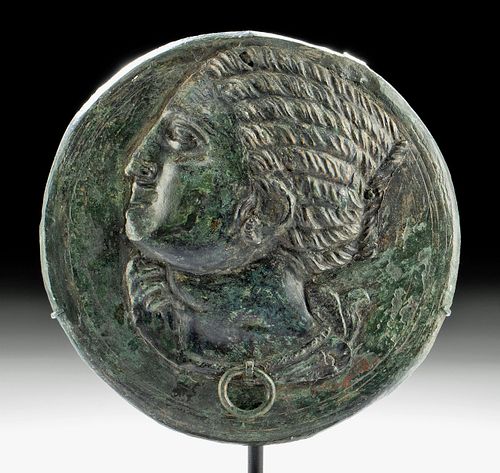Roman Bronze Mirror Case w/ Woman in Profile
Lot 44b
About Seller
Artemis Fine Arts
686 S Taylor Ave, Ste 106
Louisville, CO 80027
United States
Selling antiquities, ancient and ethnographic art online since 1993, Artemis Gallery specializes in Classical Antiquities (Egyptian, Greek, Roman, Near Eastern), Asian, Pre-Columbian, African / Tribal / Oceanographic art. Our extensive inventory includes pottery, stone, metal, wood, glass and textil...Read more
Categories
Estimate:
$7,000 - $10,000
Absentee vs Live bid
Two ways to bid:
- Leave a max absentee bid and the platform will bid on your behalf up to your maximum bid during the live auction.
- Bid live during the auction and your bids will be submitted real-time to the auctioneer.
Bid Increments
| Price | Bid Increment |
|---|---|
| $0 | $25 |
| $300 | $50 |
| $1,000 | $100 |
| $2,000 | $250 |
| $5,000 | $500 |
| $10,000 | $1,000 |
| $20,000 | $2,500 |
| $50,000 | $5,000 |
| $100,000 | $10,000 |
| $200,000 | $20,000 |
About Auction
By Artemis Fine Arts
Feb 13, 2020
Set Reminder
2020-02-13 10:00:00
2020-02-13 10:00:00
America/New_York
Bidsquare
Bidsquare : Exceptional Antiquities, Asian, Ethnographic
https://www.bidsquare.com/auctions/artemis-gallery/exceptional-antiquities-asian-ethnographic-4848
An important one-day auction featuring museum-worthy examples of Egyptian, Greek, Roman, Etruscan, Near Eastern, Far East / Asian, Pre-Columbian, African / Tribal, Oceanic, Native American, Spanish Colonial, Russian, Fossils, Ancient Jewelry, Fine Art, so much more! Artemis Fine Arts info@artemisfinearts.com
An important one-day auction featuring museum-worthy examples of Egyptian, Greek, Roman, Etruscan, Near Eastern, Far East / Asian, Pre-Columbian, African / Tribal, Oceanic, Native American, Spanish Colonial, Russian, Fossils, Ancient Jewelry, Fine Art, so much more! Artemis Fine Arts info@artemisfinearts.com
- Lot Description
Roman, Imperial Period, ca. 1st to 3rd century CE. A gorgeous bronze mirror case with an applied cast bronze relief of a woman's face in profile on its smooth, polished back side; this is held in place with tiny bronze nails. The edges of the back are folded inward, revealing an interior with a series of incised concentric circles decorating it; this would have once protected the reflective surface of a mirror. The woman's face is depicted very similarly to the popular style painted on red-figure vases known as a "lady of fashion" - a recurring motif in Apulian art believed to show a woman with her hair done elaborately for her marriage day. The "lady of fashion" is the head of a woman shown to the left, wearing a kekryphalos, a type of hair covering, earrings, and a bead necklace. Here her necklace has a separate bronze ring attached to a tiny bronze loop that serves as a pendant on the necklace but may also have once had a practice purpose, such as attaching the mirror case to a sleeve. Size: 4.7" W x 5.6" H (11.9 cm x 14.2 cm)
Mirrors are often associated with women, and specifically women's religion, in the Roman Empire: devotees of Isis carried mirrors for rituals, for example. This style of mirror is similar to ones found in the Vesuvius area, probably made in Campania. Given the "lady of fashion" motif, it may have been given as a wedding gift.
Provenance: private East Coast, USA collection; ex-Neil Phillips collection, New York, USA, acquired in the 1980s
All items legal to buy/sell under U.S. Statute covering cultural patrimony Code 2600, CHAPTER 14, and are guaranteed to be as described or your money back.
A Certificate of Authenticity will accompany all winning bids.
We ship worldwide and handle all shipping in-house for your convenience.
#152854Woman's face, which is a separate piece of bronze from the mirror back attached by bronze nails, has been expertly restored in a few areas, notably on the cheek. The back is in good condition with a few small tears around the edges. Rich patina and deposits on all surfaces.Condition
- Shipping Info
-
All shipping is handled in-house for your convenience. Your invoice from Artemis Gallery will include shipping calculation instructions. If in doubt, please inquire BEFORE bidding for estimated shipping costs for individual items.
-
- Buyer's Premium



 EUR
EUR CAD
CAD AUD
AUD GBP
GBP MXN
MXN HKD
HKD CNY
CNY MYR
MYR SEK
SEK SGD
SGD CHF
CHF THB
THB














